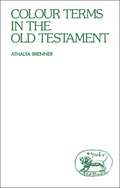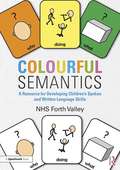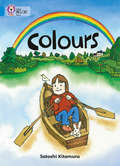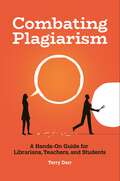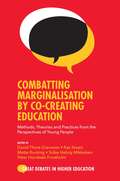- Table View
- List View
Colour in Glazes (New Ceramics)
by Linda BloomfieldA complete guide to achieving a fantastic spectrum of colourful glazes for the studio potter, Colour in Glazes looks at all the methods of achieving colour in glazes, focusing on colouring oxides in detail, including the newly available rare earth oxides. Types of base glazes and the fluxes used to make them are discussed in relation to colour response. Emphasis is placed on using colouring oxides to achieve depth and variety of colour, rather than just resorting to commercial ceramic stains. The practical aspects of mixing, applying, testing and adjusting glazes are explained and a large section of test tiles and glaze recipes is included, for use on white earthenware, stoneware and porcelain fired in electric, gas and salt kilns. A very useful book aimed at making glazes to achieve the colour you want, and to help you broaden your palette.
The Colour of Class: The educational strategies of the Black middle classes
by Nicola Rollock David Gillborn Carol Vincent Stephen J. BallHow do race and class intersect to shape the identities and experiences of Black middle-class parents and their children? What are Black middle-class parents’ strategies for supporting their children through school? What role do the educational histories of Black middle-class parents play in their decision-making about their children’s education? There is now an extensive body of research on the educational strategies of the white middle classes but a silence exists around the emergence of the Black middle classes and their experiences, priorities, and actions in relation to education. This book focuses on middle-class families of Black Caribbean heritage. Drawing on rich qualitative data from nearly 80 in-depth interviews with Black Caribbean middle-class parents, the internationally renowned contributors reveal how these parents attempt to navigate their children successfully through the school system, and defend them against low expectations and other manifestations of discrimination. Chapters identify when, how and to what extent parents deploy the financial, cultural and social resources available to them as professional, middle class individuals in support of their children’s academic success and emotional well-being. The book sheds light on the complex, and relatively neglected relations, between race, social class and education, and in addition, poses wider questions about the experiences of social mobility, and the intersection of race and class in forming the identity of the parents and their children. The Colour of Class: The educational strategies of the Black middle classes will appeal to undergraduates and postgraduates on education, sociology and social policy courses, as well as academics with an interest in Critical Race Theory and Bourdieu. The Colour of Class was awarded 2nd prize by the Society for Educational Studies: Book Prize 2016.
The Colour of Class: The educational strategies of the Black middle classes
by Nicola Rollock David Gillborn Carol Vincent Stephen J. BallHow do race and class intersect to shape the identities and experiences of Black middle-class parents and their children? What are Black middle-class parents’ strategies for supporting their children through school? What role do the educational histories of Black middle-class parents play in their decision-making about their children’s education? There is now an extensive body of research on the educational strategies of the white middle classes but a silence exists around the emergence of the Black middle classes and their experiences, priorities, and actions in relation to education. This book focuses on middle-class families of Black Caribbean heritage. Drawing on rich qualitative data from nearly 80 in-depth interviews with Black Caribbean middle-class parents, the internationally renowned contributors reveal how these parents attempt to navigate their children successfully through the school system, and defend them against low expectations and other manifestations of discrimination. Chapters identify when, how and to what extent parents deploy the financial, cultural and social resources available to them as professional, middle class individuals in support of their children’s academic success and emotional well-being. The book sheds light on the complex, and relatively neglected relations, between race, social class and education, and in addition, poses wider questions about the experiences of social mobility, and the intersection of race and class in forming the identity of the parents and their children. The Colour of Class: The educational strategies of the Black middle classes will appeal to undergraduates and postgraduates on education, sociology and social policy courses, as well as academics with an interest in Critical Race Theory and Bourdieu. The Colour of Class was awarded 2nd prize by the Society for Educational Studies: Book Prize 2016.
The Colour Photography Field Guide: The Essential Guide to Hue for Striking Digital Images (Field Guide)
by Michael FreemanUnderstand the role colour plays in your images, learn to appreciate its dynamic effects and find out how to capture and reproduce it as precisely as possible in your own images.The Colour Photography Field Guide provides a unique look at analysing and combining three important ways of dealing with colour. The first is the subjective and cultural response to individual colour: the perception. The second is how colours are found and appear in photography: the science. The third is the means by which they can be viewed and altered digitally: the expression.- A clear and technically precise look at how colour affects your digital images- Portable and lightweight, for on-the-spot information and inspiration- With a host of case studies examining difficult colour situations such as capturing flesh tones and unreal colours
Colour Terms in the Old Testament (The Library of Hebrew Bible/Old Testament Studies)
by Athalya Brenner-IdanThe OT semantic field of 'colour' is presented as a coherent, interdependent, and graded linguistic structure. The relevant lexical items are organized under the following categories: primary (basic) terms; secondary and tertiary terms; terms for pigments, dyes, painting and paints; and terms for stains, speckles, and other phenomena related to colour. Proper names, and names of objects which carry 'colour' associations are discussed as well. Many OT texts are discussed in detail. Finally, the OT colour field is compared to its Mishnaic Hebrew counterpart, and an Appendix dealing with the renewal of the same lexical sector within modern spoken Hebrew brings the study up to the present.
Colour Theory for Artists: Everything you need to know about working with colour
by Ian GoldsmithThe essential guide to colour theory and mixing for artists. Full of beautiful, intricate handpainted colour wheels and practical advice on using and mixing colour, this book is a must-have for any artist working with pigment and paint. Starting from the basics of colour and working up to the complexities of tonality, harmony, opacity and pigment, artist Ian Goldsmith explores and explains all the key elements of colour and what it can do. A comprehensive paint index at the back of the book provides an indispensable reference guide for choosing and purchasing materials that no practising artist should be without.Including:- Understanding the colour wheel - Primaries, secondaries and tertiaries- Colour temperature- Hue, value and saturation - Opacity and transparency- Materials and pigments
Colour Third Edition: A workshop for artists, designers
by David HornungTaking a practical approach to colour, Colour: A workshop for artists and designers is an invaluable resource for art students and professionals alike. With its sequence of specially designed assignments and in-depth discussions, it effectively bridges the gap between colour theory and practice to inspire confidence and understanding in anyone working with colour. This third edition is updated with more contemporary examples drawn not just from painting, but from textiles, graphic design, illustration and animation. An expanded discussion of digital techniques, new assignments and a refreshed design have all been brought together to create a highly readable and relevant text.
Colour Your Cortex: A Visual and Audio Approach to the Study of the Brain
by Emma RandlesBring your learning to life through the mindful art of colouring. Offering an alternative style of learning, this insightful book combines easy-to-follow explanations of brain anatomy and functions with detailed, labelled diagrams to colour in. While colouring, you can sit back, relax, and listen to the accompanying online audio podcast, which clearly explains each topic. The unique interactive book covers a comprehensive list of brain anatomy, including how our brains grow, brain cells and how they communicate, important functions of the brain, brain disorders and reactions, and how our brains are protected. Using a conversational tone throughout, each chapter engages the reader with succinct descriptions of each topic, allowing them to easily digest and process the information, as they colour in the accompanying diagram. The book then concludes with a chapter on mindfulness and what benefits it can have for your brain and learning.Designed to simplify complex concepts into bite-sized, understandable chunks, this is the ideal resource for psychology, neuroscience, nursing, and medical students who prefer visual and audible methods of learning. This book is also for anyone interested in understanding more about brain anatomy and functions, but with a little fun, creativity, and relaxation along the way.
Colour Your Cortex: A Visual and Audio Approach to the Study of the Brain
by Emma RandlesBring your learning to life through the mindful art of colouring. Offering an alternative style of learning, this insightful book combines easy-to-follow explanations of brain anatomy and functions with detailed, labelled diagrams to colour in. While colouring, you can sit back, relax, and listen to the accompanying online audio podcast, which clearly explains each topic. The unique interactive book covers a comprehensive list of brain anatomy, including how our brains grow, brain cells and how they communicate, important functions of the brain, brain disorders and reactions, and how our brains are protected. Using a conversational tone throughout, each chapter engages the reader with succinct descriptions of each topic, allowing them to easily digest and process the information, as they colour in the accompanying diagram. The book then concludes with a chapter on mindfulness and what benefits it can have for your brain and learning.Designed to simplify complex concepts into bite-sized, understandable chunks, this is the ideal resource for psychology, neuroscience, nursing, and medical students who prefer visual and audible methods of learning. This book is also for anyone interested in understanding more about brain anatomy and functions, but with a little fun, creativity, and relaxation along the way.
Colourful Modern Calligraphy
by Milly WithersMaster the art of modern calligraphy and use colour to create your own unique style. This book explains the basics of modern calligraphy, breaking down each stroke and letterform with helpful tips and useful guide sheets. But it does much more than this by showing you how to design and use colour to make your words come alive on paper. Bursting with the author's enthusiasm, it features ten projects that showcase how to achieve professional results, how to use calligraphy in new ways and how to create a unique style for your work.
Colourful Semantics: A Resource for Developing Children’s Spoken and Written Language Skills
by NHS Forth ValleyThis comprehensive resource pack, developed in conjunction with education staff, draws on the principles of Alison Bryan’s original Colourful Semantics approach to provide professionals with an engaging, dynamic way to support children’s language development. By coding sentences using colour, symbols and signs, this visual approach aims to: Teach understanding of question words Develop vocabulary and increase sentence complexity Increase range and complexity of verbs (children with delayed or disordered spoken language skills often overuse simple verbs such as do, go or get) Improve children’s written language skills This practical resource consists of three parts: a printed book containing ready-made session plan ideas, black and white vocabulary cards and worksheets; an online version using the current Colourful Semantics colour coding system, and an online version using the colour coding system used by Speech and Language Therapists from NHS Forth Valley. This is an essential pack for teachers and professionals looking to work on language development with children aged four to nine. The flexible session plans can be used with individuals, small groups and whole classes, and can be easily adapted by Speech and Language Therapists, teachers and other practitioners.
Colourful Semantics: A Resource for Developing Children’s Spoken and Written Language Skills
by NHS Forth ValleyThis comprehensive resource pack, developed in conjunction with education staff, draws on the principles of Alison Bryan’s original Colourful Semantics approach to provide professionals with an engaging, dynamic way to support children’s language development. By coding sentences using colour, symbols and signs, this visual approach aims to: Teach understanding of question words Develop vocabulary and increase sentence complexity Increase range and complexity of verbs (children with delayed or disordered spoken language skills often overuse simple verbs such as do, go or get) Improve children’s written language skills This practical resource consists of three parts: a printed book containing ready-made session plan ideas, black and white vocabulary cards and worksheets; an online version using the current Colourful Semantics colour coding system, and an online version using the colour coding system used by Speech and Language Therapists from NHS Forth Valley. This is an essential pack for teachers and professionals looking to work on language development with children aged four to nine. The flexible session plans can be used with individuals, small groups and whole classes, and can be easily adapted by Speech and Language Therapists, teachers and other practitioners.
Colours: Band 04/blue (Collins Big Cat)
by Satoshi KitamuraA simple text where a visit to an art show causes a girl to imagine what the world would be like if it was wholly yellow, red or blue. Realising that the world actually consists of all the colours of the rainbow, she paints lots of multicoloured pieces of art herself.
Colours: A Drawing Book Inspired by Art (True Colour Ser.)
by Giovanna RanaldiMany people crave a creative outlet, but more often than not, don't know where to start. In Colours, Giovanna Ranaldi invites you to nurture your creativity and build your confidence by taking inspiration from famous works of art that celebrate colour.Each section explores a particular aspect of colour, from basics such as the history of the colour wheel and using complementary colours, to understanding the impact colour has on our emotions and dreams. Throughout the book, Giovanna provides creative and fun prompts that will encourage you to draw or paint on the pages using various techniques. Colours is full of information on how to see colour and use it in your own artwork and is packed with inspiration from the world's most celebrated artists, including Paul Klee, Claude Monet, Vincent van Gogh, Sonia Delaunay and more.Colours is a short course in unlocking your creative self – perfect for budding artists of all ages who are keen to try out different artistic techniques and materials, and begin their artistic journey.
Colours and Shapes Flashcards 3+ (Collins Easy Learning Preschool)
by Collins Easy LearningLevel: EYFS. Subject: Maths. The perfect resource for learning colours and shapes at home!
Combating Educational Disadvantage: Meeting the Needs of Vulnerable Children
by Theo CoxThe New Labour Government puts Education, Education, Education at the heart of its agenda but is it doing enough to combat educational disadvantage?Combating Educational Disadvantage sets the discussion of educational disadvantage within the socio-political context of the 1980s and 1990s, with its market philosophy in education and brings together the contributions of leading writers and researchers of international standing.
Combating Educational Disadvantage: Meeting the Needs of Vulnerable Children
by Theo CoxThe New Labour Government puts Education, Education, Education at the heart of its agenda but is it doing enough to combat educational disadvantage?Combating Educational Disadvantage sets the discussion of educational disadvantage within the socio-political context of the 1980s and 1990s, with its market philosophy in education and brings together the contributions of leading writers and researchers of international standing.
Combating Plagiarism: A Hands-On Guide for Librarians, Teachers, and Students
by Terry DarrOffers an instructional plan for plagiarism education for middle school and high school students, allowing librarians to become a resource for students, teachers, and school administrators.The proliferation of resources now available through libraries and the internet requires a new set of information management skills in order for students to avoid plagiarism. While educators legitimately expect students to approach academic work with honesty and integrity, students need to be able to understand the context of their academic resources—both print and digital—well enough to use them appropriately and ethically. Combating Plagiarism helps middle and high school teachers and librarians understand and teach the authorship and publication process so students learn to use relevant information in an ethically and academically sound fashion.Terry Darr's long-term collaboration with a high school history teacher taught her the challenges faced by students conducting research—and by librarians and teachers tasked with teaching plagiarism prevention. Her book is full of tested concepts for teaching these complex topics, emphasizing our modern reliance on digital sources. An extensive student reference section covers common knowledge, fact, and opinion. A wealth of practical resources includes real-life examples from research papers as well as plenty of instructional materials, exercises, and lesson plans.
Combating Plagiarism: A Hands-On Guide for Librarians, Teachers, and Students
by Terry DarrOffers an instructional plan for plagiarism education for middle school and high school students, allowing librarians to become a resource for students, teachers, and school administrators.The proliferation of resources now available through libraries and the internet requires a new set of information management skills in order for students to avoid plagiarism. While educators legitimately expect students to approach academic work with honesty and integrity, students need to be able to understand the context of their academic resources—both print and digital—well enough to use them appropriately and ethically. Combating Plagiarism helps middle and high school teachers and librarians understand and teach the authorship and publication process so students learn to use relevant information in an ethically and academically sound fashion.Terry Darr's long-term collaboration with a high school history teacher taught her the challenges faced by students conducting research—and by librarians and teachers tasked with teaching plagiarism prevention. Her book is full of tested concepts for teaching these complex topics, emphasizing our modern reliance on digital sources. An extensive student reference section covers common knowledge, fact, and opinion. A wealth of practical resources includes real-life examples from research papers as well as plenty of instructional materials, exercises, and lesson plans.
Combating Social Exclusion in University Adult Education (Routledge Revivals)
by Julia PreecePublished in 1999, this work suggests that widening participation is not just about changing learner expectations; it is also about changing institutional expectations and practices. "Higher" learning, for example, should include a broader, more inclusive range of knowledge and ways of knowing than at present and criteria for learning achievement should include assessment of "citizenship" as well as linear outcomes.
Combating Social Exclusion in University Adult Education (Routledge Revivals)
by Julia PreecePublished in 1999, this work suggests that widening participation is not just about changing learner expectations; it is also about changing institutional expectations and practices. "Higher" learning, for example, should include a broader, more inclusive range of knowledge and ways of knowing than at present and criteria for learning achievement should include assessment of "citizenship" as well as linear outcomes.
Combatting Marginalisation by Co-Creating Education: Methods, Theories and Practices from the Perspectives of Young People (Great Debates in Higher Education)
by David Thore Gravesen, Kaz Stuart, Mette Bunting, Sidse Hølvig Mikkelsen, Peter Hornbæk FrostholmThe result of collaboration between students and researchers across Europe as part of an Erasmus+ funded project, this book sheds light on power structures and exclusion processes in education from the perspectives of young people. Bridging practical, empirical and theoretical questions, and focusing on young people’s stories in and outside of school, this edited collection delves into the narratives of young respondents that have experienced severe challenges in their school life. Written in three parts, the authors introduce the basic concepts surrounding social inclusion and equality, present chapters written and co-written with students, and consider the implications and models for practice, both in schools, youth work and higher education. Including a final chapter written by guest author Distinguished Professor Michelle Fine, who reflects on the project, and the potentials for future education, youth work and research, this book invites readers to better understand marginalization and how to build an inclusive educational future.
Combatting Marginalisation by Co-Creating Education: Methods, Theories and Practices from the Perspectives of Young People (Great Debates in Higher Education)
by David Thore Gravesen Kaz Stuart Mette Bunting Sidse Hølvig Mikkelsen Peter Hornbæk FrostholmThe result of collaboration between students and researchers across Europe as part of an Erasmus+ funded project, this book sheds light on power structures and exclusion processes in education from the perspectives of young people. Bridging practical, empirical and theoretical questions, and focusing on young people’s stories in and outside of school, this edited collection delves into the narratives of young respondents that have experienced severe challenges in their school life. Written in three parts, the authors introduce the basic concepts surrounding social inclusion and equality, present chapters written and co-written with students, and consider the implications and models for practice, both in schools, youth work and higher education. Including a final chapter written by guest author Distinguished Professor Michelle Fine, who reflects on the project, and the potentials for future education, youth work and research, this book invites readers to better understand marginalization and how to build an inclusive educational future.
Combinatorics and Reasoning: Representing, Justifying and Building Isomorphisms (Mathematics Education Library #47)
by Carolyn A. Maher Arthur B. Powell Elizabeth B. UptegroveCombinatorics and Reasoning: Representing, Justifying and Building Isomorphisms is based on the accomplishments of a cohort group of learners from first grade through high school and beyond, concentrating on their work on a set of combinatorics tasks. By studying these students, the editors gain insight into the foundations of proof building, the tools and environments necessary to make connections, activities to extend and generalize combinatoric learning, and even explore implications of this learning on the undergraduate level. This volume underscores the power of attending to basic ideas in building arguments; it shows the importance of providing opportunities for the co-construction of knowledge by groups of learners; and it demonstrates the value of careful construction of appropriate tasks. Moreover, it documents how reasoning that takes the form of proof evolves with young children and discusses the conditions for supporting student reasoning.
Combinatorics and Reasoning: Representing, Justifying and Building Isomorphisms (Mathematics Education Library #47)
by Elizabeth B. Uptegrove Carolyn A. Maher Arthur B. PowellCombinatorics and Reasoning: Representing, Justifying and Building Isomorphisms is based on the accomplishments of a cohort group of learners from first grade through high school and beyond, concentrating on their work on a set of combinatorics tasks. By studying these students, the editors gain insight into the foundations of proof building, the tools and environments necessary to make connections, activities to extend and generalize combinatoric learning, and even explore implications of this learning on the undergraduate level. This volume underscores the power of attending to basic ideas in building arguments; it shows the importance of providing opportunities for the co-construction of knowledge by groups of learners; and it demonstrates the value of careful construction of appropriate tasks. Moreover, it documents how reasoning that takes the form of proof evolves with young children and discusses the conditions for supporting student reasoning.



